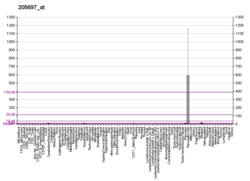Secretagogin
Secretagogin is a protein that in humans is encoded by the SCGN gene.[5][6]
Function
The encoded protein is a secreted calcium-binding protein which is found in the cytoplasm. It is related to calbindin D-28K and calretinin. This protein is thought to be involved in potassium chloride-stimulated calcium flux and cell proliferation.[6] This protein plays an important role in the release of the stress hormone Corticotropin-releasing hormone (CRH) and which only then enables stress processes in the brain.
References
- 1 2 3 GRCh38: Ensembl release 89: ENSG00000079689 - Ensembl, May 2017
- 1 2 3 GRCm38: Ensembl release 89: ENSMUSG00000021337 - Ensembl, May 2017
- ↑ "Human PubMed Reference:".
- ↑ "Mouse PubMed Reference:".
- ↑ Wagner L; Oliyarnyk O; Gartner W; Nowotny P; Groeger M; Kaserer K; Waldhausl W; Pasternack MS (Sep 2000). "Cloning and expression of secretagogin, a novel neuroendocrine- and pancreatic islet of Langerhans-specific Ca2+-binding protein". J Biol Chem. 275 (32): 24740–51. doi:10.1074/jbc.M001974200. PMID 10811645.
- 1 2 "Entrez Gene: SCGN secretagogin, EF-hand calcium binding protein".
Further reading
- Gartner W, Lang W, Leutmetzer F, et al. (2002). "Cerebral expression and serum detectability of secretagogin, a recently cloned EF-hand Ca(2+)-binding protein". Cereb. Cortex. 11 (12): 1161–9. doi:10.1093/cercor/11.12.1161. PMID 11709487.
- Mungall AJ, Palmer SA, Sims SK, et al. (2003). "The DNA sequence and analysis of human chromosome 6". Nature. 425 (6960): 805–11. doi:10.1038/nature02055. PMID 14574404.
- Zhan X; Evans CO; Oyesiku NM; Desiderio DM (2004). "Proteomics and transcriptomics analyses of secretagogin down-regulation in human non-functional pituitary adenomas". Pituitary. 6 (4): 189–202. doi:10.1023/B:PITU.0000023426.99808.40. PMID 15237930.
- Zierhut B, Daneva T, Gartner W, et al. (2005). "Setagin and secretagogin-R22: Posttranscriptional modification products of the secretagogin gene". Biochem. Biophys. Res. Commun. 329 (4): 1193–9. doi:10.1016/j.bbrc.2005.02.093. PMID 15766553.
- Skovhus KV, Bergholdt R, Erichsen C, et al. (2007). "Identification and characterization of secretagogin promoter activity". Scand. J. Immunol. 64 (6): 639–45. doi:10.1111/j.1365-3083.2006.01854.x. PMID 17083620.
- Romanov R.; Alpar A.; et al. (2014). "A secretagogin locus of the mammalian hypothalamus controls stress hormone release". EMBO Journal. 34: 36–54. doi:10.15252/embj.201488977. PMC 4291479.
This article is issued from
Wikipedia.
The text is licensed under Creative Commons - Attribution - Sharealike.
Additional terms may apply for the media files.




